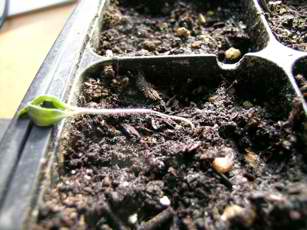There are few plants that deal with excessive water, and most of them aren’t desirable for food or ornamental uses. Not properly managing moisture can cause all kinds of problems for the indoor gardener. Its especially troublesome in container growing, much more so when the heat of the sun and the drying breeze is missing from the plant’s environment. An issue that is magnified with plastic containers that do not allow air flow through the walls.
 Containers present the inexperienced grower with a myriad of ways to go wrong. The most common being insufficient drainage and bad watering practices. The medium in the container has a lot to do with many a trouble caused by too much moisture too. So does trying to grow in containers that have no drainage holes in the bottom. Plants only need as much moisture as they can absorb and stops their roots from drying out. Sitting in a swamp however is completely different. If they don’t drown, they will rot or become the victim of a disease of some sort.
Containers present the inexperienced grower with a myriad of ways to go wrong. The most common being insufficient drainage and bad watering practices. The medium in the container has a lot to do with many a trouble caused by too much moisture too. So does trying to grow in containers that have no drainage holes in the bottom. Plants only need as much moisture as they can absorb and stops their roots from drying out. Sitting in a swamp however is completely different. If they don’t drown, they will rot or become the victim of a disease of some sort.
The most fragile growth stage for any plant is the germination period. There just isn’t enough root, stem or leaves to deal with conditions that are too dry or too wet. The problem in the image here is very common and leaves a lot of new growers puzzled as to what happened. It’s called damping off and is caused by bad drainage that is usually a side effect of poor potting soil that retains too much moisture. It will definitely do in your seed starting abilities if you try container growing with regular ground soil. The two just don’t play well together, which is why we have soilless mixes for growing plants of any kind in a container.
Damping off is many times mistaken as a sign that the new plants got too dry. Sorry, but thirsty plants don’t flop their full length on the ground. They might droop a little and the leaves look a bit withered, but fall right over at the soil line? Never. Some people use chemicals to ward off this plant disease, but in growing food plants you certainly wouldn’t want to do this. The problem with chemical correction of what ails your plant is that it is really treating the by product of something that you could most likely have never given room to take place originally. You need to learn to work with the plant’s requirements, not react with ‘pharmaceutics’.
 Damped off plants might as well be tossed out. The disease cuts off all food and moisture that the top of the plant needs. It isn’t going to repair. The stem at the soil line will be brown and pinched or withered, so no life blood is going to support any further growth.
Damped off plants might as well be tossed out. The disease cuts off all food and moisture that the top of the plant needs. It isn’t going to repair. The stem at the soil line will be brown and pinched or withered, so no life blood is going to support any further growth.
Some plants are more susceptible to damping off than others. They will be drought lovers. So before you try to start any new plants, be sure you know what kind of moisture situation they love. Tomatoes for instance are much healthier with lower moisture than an over abundance of it. Cucumbers, melons and squash will easily get powdery mildew if you water them too much in the outdoor garden. Imagine how they will fare in your indoor garden if your potting mix does not drain well. Steer clear of straight peat moss! It not only doesn’t drain well alone, but remains packed to close together which doesn’t allow any fresh air to reach roots.
Don’t use cheap potting mix. It is inferior and will give you many headaches. You’ll find it a lot easier to grow fresh food with good quality soilless mixes than the bargain brands.
Don’t use repurposed containers without putting good drainage holes in the bottom. Don ‘t reuse growing containers without sterilizing them first. Damping off is a soil-borne fungus and can spread from one crop to another when using containers over again. Sterilize them with bleach water first, because it might not be your watering practices or your selection of medium with recycled growing containers.
If you’re germinating seeds, get a proper germination tray. You’ll use it over and over again for years and its well worth the investment. Just make sure you sterilize it with each new sowing you start.
Nature never allows anything to grow where it’s perfect conditions aren’t met. A seed may need only moisture to come to life, but once it starts growing mature shaped leaves, its going to need the right environmental conditions to live longer than 2-3 weeks.